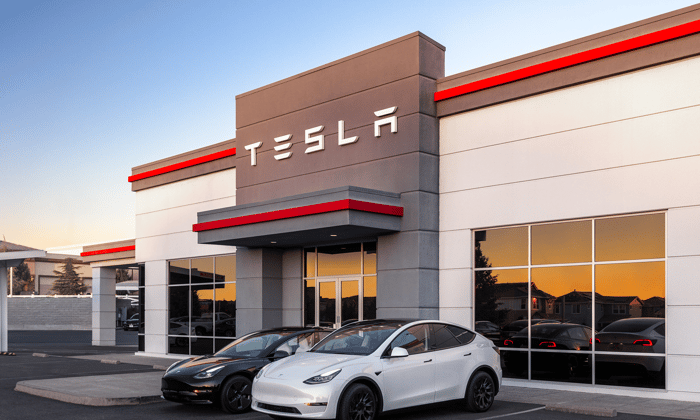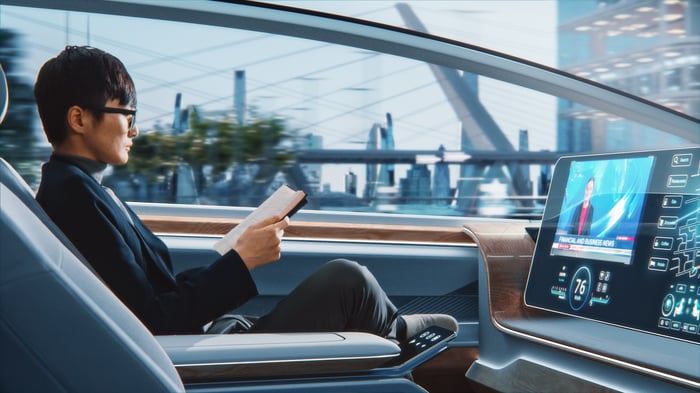Tesla (TSLA -1.29%) is one of the world's leading manufacturers of electric vehicles (EVs), but investors are currently more focused on products like its full self-driving software (FSD), Cybercab robotaxi, and Optimus robot, which could each be trillion-dollar platforms in the future.
Cathie Wood is the founder of Ark Investment Management, which operates exchange-traded funds (ETFs) filled with innovative technology stocks, and Tesla is the firm's largest holding overall. Last year, Ark released a report suggesting Tesla stock could soar to $2,600 by 2029 on the back of products like FSD and the Cybercab alone.
However, the stock plummeted by 43% from its recent record high as of this writing, amid serious weakness in the company's core EV business. But Wood is undeterred -- in an interview with Bloomberg TV last Tuesday, she reiterated Ark's $2,600 price target for Tesla stock, which implies an eyewatering potential upside of 855%.
Here's what investors need to know before buying the stock based on Wood's prediction.

Image source: Tesla.
Tesla's EV sales are plunging worldwide
Toward the end of 2023, Tesla CEO Elon Musk told investors he planned to grow the company's EV production by 50% per year going forward. Tesla delivered a record 1.8 million cars that year, but it was only a 38% year-over-year increase. Then, in 2024, the company's deliveries shrank by 1%.
Simply put, Musk can't realize his goal to grow production by 50% annually if the demand isn't there from consumers -- and 2025 could throw an even bigger spanner in the works. During January and February, Tesla's EV sales across Europe plunged 43% compared to the same period last year. Sales also crashed by 66% in Australia, and they are on track to be flat, at best, in China for the first quarter overall.
To make matters worse, EV sales are actually climbing in most countries, which suggests that consumers are shunning Tesla in favor of other brands. That problem has a few layers.
First, competitors like China-based BYD and Great Wall Motors are currently selling base-model EVs for under $15,000 in their domestic market, and both companies are expanding globally at a rapid pace. Tesla simply can't compete at that price point.
Second, many consumers might be thinking twice about buying a Tesla because of Musk's involvement in U.S. and international politics, which seems to have triggered a growing number of violent attacks on dealerships and privately owned vehicles. Some experts think these issues could drive insurance premiums higher over time, but there have also been reports of a significant rise in the number of owners trading in their Teslas, which is collapsing resale values.

Image source: Getty Images.
Wood's prediction rests on the success of autonomous driving
Tesla generated $97.6 billion in revenue last year, and 79% of it came from EV sales. However, Ark's financial models suggest EV sales will represent just 26% of the company's revenue by 2029, with autonomous ride-hailing making up the majority instead.
Tesla's Cybercab will be central to this new business. It's a fully autonomous robotaxi that will run entirely on the company's FSD software -- in fact, the car won't even have pedals or a steering wheel. It will be capable of hauling passengers (and small commercial deliveries) without human input, so it can generate revenue around the clock.
FSD hasn't been approved for unsupervised use on U.S. roads just yet, which is a barrier to getting the Cybercab up and running, but Musk is hopeful it will get the green light from regulators in California and Texas this year. Nevertheless, it places Tesla significantly behind Alphabet's Waymo, which is already completing over 200,000 paid autonomous trips every week across San Francisco, Los Angeles, and Phoenix.
When Tesla's autonomous ride-hailing service is eventually up and running, Ark thinks it will grow so rapidly that it could generate $756 billion in annual revenue by 2029, accounting for 63% of the company's $1.2 trillion in total revenue. That will pave the way for Tesla's valuation to reach $8 trillion, according to Ark, which is how the firm (and Wood) arrived at the $2,600 prediction for its stock.
In my opinion, Ark's financial models are a little ambitious. Tesla launched its flagship Model S EV in 2011, and it took 14 years for the company to expand its lineup and reach almost $100 billion in annual revenue. Therefore, the idea that it will grow its revenue 12-fold to $1.2 trillion within the next five years seems very optimistic, especially since the Cybercab isn't expected to reach mass production until 2026.
NASDAQ: TSLA
Key Data Points
Tesla stock is extremely expensive right now
Tesla's earnings per share (EPS) plunged by 53% during 2024, coming in at $2.04. The company slashed the price of many of its EVs to encourage demand, which significantly eroded its profit margins.
That places Tesla stock at an eyewatering price-to-earnings (P/E) ratio of 134, making it almost six times more expensive than the broader stock market, based on the 22.9 P/E ratio of the S&P 500 index.
Tesla stock would have to plunge by another 82% from here just to trade in line with the S&P 500. However, the situation could get even worse because the company's EPS will almost certainly decline further this year if its EV deliveries continue to shrink, paving the way for even more downside in its stock price.
With all of that said, Tesla stock might be a bargain at the current price if Ark's forecasts for 2029 prove to be accurate. However, that doesn't mean investors should pay a substantial premium for the stock today because there is such a high risk of further downside in the short term.
Remember, Ark's projections rest on the success of unsupervised FSD and the Cybercab, neither of which is actually operational in the real world yet. It's impossible to know whether Tesla will successfully commercialize those products or whether consumers will actually like them. As a result, investors should interpret the recent 43% drop in Tesla stock as a sign to steer clear for now.




